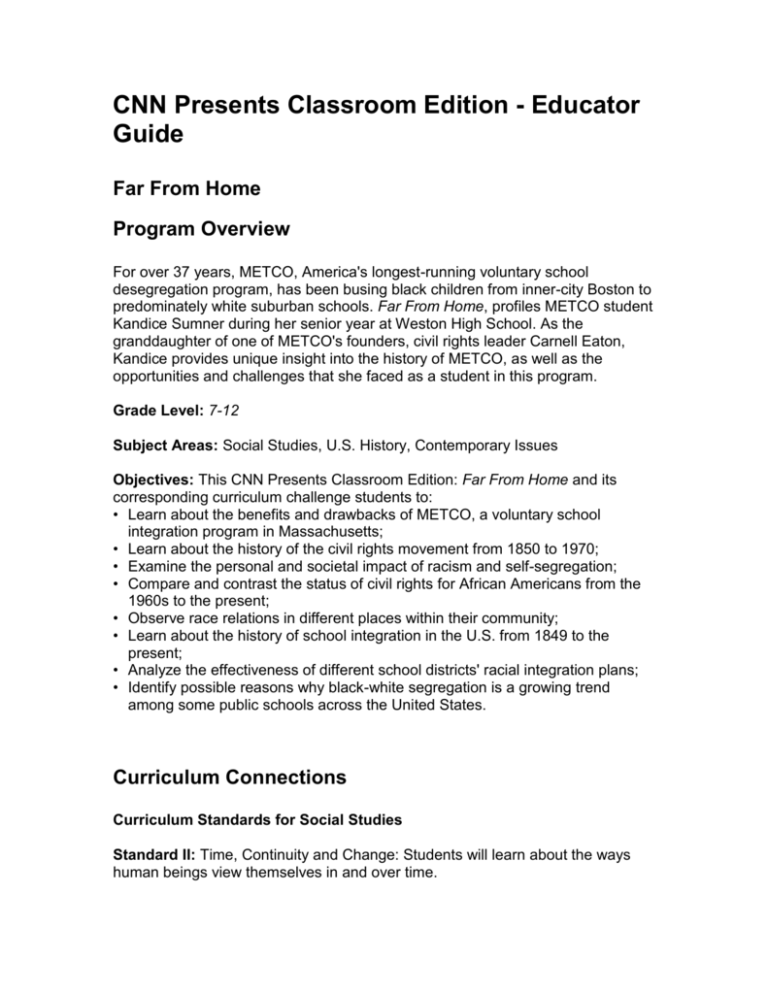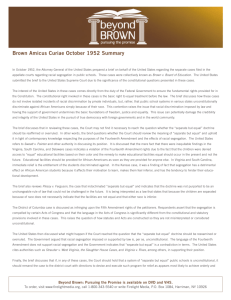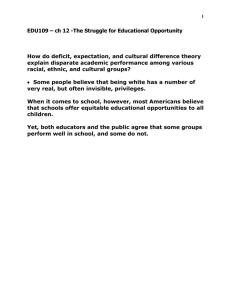
CNN Presents Classroom Edition - Educator
Guide
Far From Home
Program Overview
For over 37 years, METCO, America's longest-running voluntary school
desegregation program, has been busing black children from inner-city Boston to
predominately white suburban schools. Far From Home, profiles METCO student
Kandice Sumner during her senior year at Weston High School. As the
granddaughter of one of METCO's founders, civil rights leader Carnell Eaton,
Kandice provides unique insight into the history of METCO, as well as the
opportunities and challenges that she faced as a student in this program.
Grade Level: 7-12
Subject Areas: Social Studies, U.S. History, Contemporary Issues
Objectives: This CNN Presents Classroom Edition: Far From Home and its
corresponding curriculum challenge students to:
• Learn about the benefits and drawbacks of METCO, a voluntary school
integration program in Massachusetts;
• Learn about the history of the civil rights movement from 1850 to 1970;
• Examine the personal and societal impact of racism and self-segregation;
• Compare and contrast the status of civil rights for African Americans from the
1960s to the present;
• Observe race relations in different places within their community;
• Learn about the history of school integration in the U.S. from 1849 to the
present;
• Analyze the effectiveness of different school districts' racial integration plans;
• Identify possible reasons why black-white segregation is a growing trend
among some public schools across the United States.
Curriculum Connections
Curriculum Standards for Social Studies
Standard II: Time, Continuity and Change: Students will learn about the ways
human beings view themselves in and over time.
2
Standard VI: Power, Authority and Governance: Social studies programs should
include experiences that provide for the study of how people create and change
structures of power, authority, and governance.
The Curriculum Standards for Social Studies
(http://www.socialstudies.org/standards/) are published by the National Council
for Social Studies (http://ncss.org/).
United States History Standards
Era 9 - Postwar United States (1945 to early 1970s)
Standard 28: Understands domestic policies in the post-World War II period
Level III Grade: 7-8
Benchmark 1: Understands the domestic policies of Presidents Truman and
Eisenhower (e.g., Eisenhower's "Modern Republicanism," Truman's Fair Deal
program for securing fair employment practices, desegregation, civil rights, and
race relations)
Standard 29: Understands the struggle for racial and gender equality and for the
extension of civil liberties
Level III Grade: 7-8
Benchmark 1: Understands individual and institutional influences on the civil
rights movement (e.g., the origins of the postwar civil rights movement; the role
of the NAACP in the legal assault on the leadership and ideologies of Martin
Luther King, Jr. and Malcolm X; the effects of the constitutional steps taken in the
executive, judicial, and legislative branches of government; the shift from de jure
to de facto segregation; important milestones in the civil rights movement
between 1954 and 1965; Eisenhower's reasons for dispatching federal troops to
Little Rock in 1957)
Era 10 - Contemporary United States (1968 to the present)
Standard 31: Understands economic, social, and cultural developments in the
contemporary United States
Level III Grade: 7-8
Benchmark 4: Understands various influences on American culture (e.g., the
desegregation of education and its role in the creation of private white
academies; the influence of the media on contemporary American culture; how
ethnic art, food, music, and clothing are incorporated into mainstream culture and
3
society)
McREL: Content Knowledge: A Compendium of Standards and Benchmarks for
K-12 Education (Copyright 2000 McREL) is published online by Mid-continent
Research for Education and Learning (McREL) (http://www.mcrel.org/standardsbenchmarks ), 2550 S. Parker Road, Suite 500, Aurora, CO 80014.
Discussion Questions
1. What is METCO? What is the goal of this program? When was METCO
established? Do you think it's important for all Americans to have equal access to
quality education? Why or why not?
2. Who is Kandice Sumner? In what city did she grow up? Why did she
participate in the METCO program? What high school did she attend? Do you
agree with Kandice that this is "a typical" high school? Why or why not?
3. What historic position did Kandice hold in her school's student government?
What challenges did Kandice face as a METCO student? To what extent was the
issue of racial difference a factor in her high school experience? Give examples.
Has this issue been a factor in your school experience? Explain. Do you think
you are aware of racial differences to the same degree as Kandice? Why or why
not?
4. What misconceptions did some of the white students have about Kandice
because of her race? Why do you think these stereotypes exist? How did these
misconceptions make Kandice feel? How did Kandice try to combat these
misconceptions? How do you think you would have handled these situations if
you were in Kandice's shoes?
5. How would you describe Kandice's relationship with her family? To what TV
family has her family been compared? Do you think this is an accurate
comparison? Why or why not? Based on the information in the program, what
values do you think are important to Kandice's family? Do you think these values
are unique to the Sumners? Explain.
6. Who was Carnell Eaton and what role did he play in the METCO program?
How did he die? How has Eaton's legacy appeared to influence Kandice?
7. What is segregation? What potential problems are associated with racial
segregation? Do you think racially segregated schools are inherently unequal?
Why or why not?
8. According to the program, why did Kandice choose to sit with other METCO
4
students during lunch? Do you think that socializing with one's own ethnic group
is a matter of comfort or bias? Do the students in your school segregate
themselves by race? Explain. Do you think it's important to encourage interaction
among students of all races? State your rationale. If so, what can students at
your school do to address existing racial divisions?
9. In the program, Kandice says that "it's very easy to fall through the cracks in
Weston if you don't know how to play the game." To what process is she
referring? Why do you think she refers to this process as a "game"? Do you
agree with Kandice that this process needs to be changed? Why or why not? If
so, what changes do you think need to be made?
10. What is "affirmative action"? What do you think Kandice's mother Katani
meant when she said that "networking is white people's affirmative action"? Do
you agree with her assertion? Why or why not?
11. To which colleges did Kandice apply? Why did she choose these schools?
Which college is she currently attending? If you were in Kandice's shoes, which
of the colleges she applied to would you have wanted to attend? Why?
Suggested Activities
1. Civil Rights Movement
Refer student groups to multimedia resources, including the links blow, to learn
about the history of the civil rights movement from 1850 to 1970. After students
conclude their research, have each group share its findings with the class. As a
class, create a timeline that depicts the key events, people and legislation related
to the civil rights movement.
Then, ask students: What was the racial climate in the U.S. 36 years ago? To
what extent are civil rights for African Americans still an issue in the United
States? Challenge each student to use Web sites, newspapers and magazines to
compare and contrast the status of civil rights for African Americans during the
1960s to the present. Have students create charts or graphic organizers that
depict these similarities and differences. After students present their creations,
challenge them to identify non-violent solutions for the social inequities that they
perceive currently exist. Wrap up the activity by reminding students that, in the
program, Gloria Eaton, the wife of civil rights activist Carnell Eaton, asserts that
we don't have civil rights fighters like Martin Luther King, Jr. and Carnell Eaton
anymore. Ask students: Do you agree with Gloria Eaton? Why or why not? If you
do agree with Eaton, why do you think this shift has occurred?
2. Racism
5
Ask students: What is racism? Why does it exist? Why is racism problematic for
individuals and society? What is the state of race relations in your school and
community? Following the discussion, have students observe race relations in
different places within their community. Help students to brainstorm a list of
places they may want to observe, such as:
• the school cafeteria,
• a hospital,
• a mall,
• a ballpark or other sports site,
• a classroom,
• public transportation.
Instruct students to write reports of their findings and share them with the class.
Then, ask: Does racism exist in your community? If so, what is being done to
address the issue? If racism doesn't exist, what could other communities learn
from yours?
3. School Integration
Direct student groups to the Web sites below, and other resources, to learn about
the history of school integration in the U.S. from 1849 to the present, including
the landmark Brown vs. Board of Education case. Have groups share their
findings with the class and consider to what extent school integration is important
for individuals and for society.
Then, assign each group a different U.S. state. Challenge groups to find out how
different districts in their assigned states have attempted to promote racial
integration. After groups deliver formal presentations of their findings, have
students compare and contrast the different school integration plans. Ask: Which
plans were successful? Which ones were met with resistance? In your opinion,
what are the benefits and drawbacks of forced integration and voluntary
integration?
Finally, point out that, at the end of Far From Home, we learn that black-white
school segregation is at an all-time high in Boston, and that this trend is reflected
in public schools across the United States. Ask students: Why do you think this is
the case? In your opinion, is this a problem? Why or why not? What, if anything,
should individuals, communities and governments do about the issue of school
segregation? Do you think busing is an effective method of integrating public
schools?
6
Suggested Online Resources
Metropolitan Council for Educational Opportunity (METCO)
(http://www.metcoinc.org)
Weston High School (http://www.westonschools.org/schools/hs/top/)
Spelman College (http://www.spelman.edu/)
Brown University (http://www.brown.edu/)
CNNstudentnews.com: History of Segregation
(http://cnnstudentnews.cnn.com/2001/fyi/lesson.plans/
02/01/bhm.backgrounder.history.segregation/)
Busing in Boston: Looking Back at the History and Legacy
(http://www.gse.harvard.edu/news/features/busing09012000_page1.html)
A Brief History of Civil Rights in the United States of America: School
Busing (http://www.africanamericans.com/SchoolBusing.htm)
BROWN V. BOARD: Timeline of School Integration in the U.S.
(http://www.tolerance.org/teach/expand/mag/features.jsp?p=0&is=34&ar=48
7)
CNN Presents Classroom Edition: The Gap: 50 Years After the Brown
Ruling --Educator Guide
(http://cnnstudentnews.cnn.com/2004/fyi/news/05/12/cnnpce.the.gap/)
Brown v. Board of Education: National Historic Site
(http://www.nps.gov/brvb/home.htm)
CNNstudentnews.com: Black History Month Resources
(http://cnnstudentnews.cnn.com/fyi/teachers/backgrounders/bhm.resource
s/)
Encyclopedia.com: Civil Rights
(http://www.encyclopedia.com/html/section/civilrig_civilrightsintheunitedst
ates.asp)
Jim Crow History (http://www.jimcrowhistory.org/history/history.htm)
Timeline of the Equal Rights Movement in America
(http://americanhistory.si.edu/timeline/07sitin.htm)
7
Terms
Metropolitan Council for Educational Opportunity (METCO), Boston,
Massachusetts, suburban, Weston High School, inner-city schools, racism,
stereotypes, segregation, educational opportunities, African American,
Caucasian, busing, racial integration, Kandice Sumner, Carnell Eaton, civil rights
movement, Brown University, Spelman College
© 2005 Cable News Network LP, LLLP.
A Time Warner Company. All Rights Reserved.






